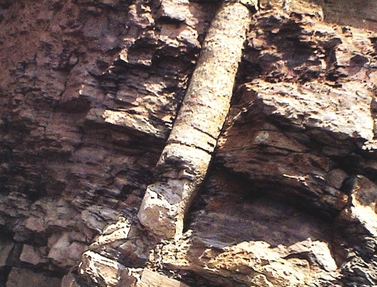 |
 |
 |
 |
 |
 |
 |
 |
|
 |
 |
 |
26 Polystrate fossils
|
| Menu | back |
|
Time and again one finds fossil tree trunks, plants and animals, which extend through several geological layers (Polystrate fossils). The problem is that these layers are often attributed a radiometric age difference of several thousand or even tens of thousands of years. Thus, on the Hauenstein (in Switzerland) an ichthyosaur fossil, which extended through three layers, was found. Since fish start to decompose within a few days, layers such as the one on the Hauenstein must have formed very quickly. A tree trunk must be encased within a few years, or decades, for it to become petrified; otherwise it disintegrates.
The article Hauenstein ichthyosaur puzzle solved? in the NZZ (New Zurich Newspaper) on March 12, 2004, is an example of how the model of a billion-year-old Earth is taken for granted in the public media. The attempted explanation, that the ichthyosaur fossil of Hauenstein was retroactively impelled through several layers by an internal explosion, is somewhat strange (1). How could the carcass have remained completely undamaged?
"Unusual means" in interdisciplinary research and collaboration provided the answer to the embedding and fossilisation of the Hauensteiner Dickschädel. Apart from the classic methods of geology and palaeontology, forensic and veterinary medicine, gynaecology, marine biology, computer tomography, submarine technology as well as other methods were employed (2).
The original paper by Hannes Hänggi and Achim G. Reisdorf has certainly earned recognition (3). Assuming that the ichthyosaur really is 190 million years old and that the layers through which it extends must be ascribed an age difference of more than just a few days, they have worked out a valid explanation.
Which of the following explanations is yet, in the final analysis, more plausible?
|
| a) |
The carcass was retroactively impelled through several layers and remained undamaged, or
|
| b) |
The limestone layers in which the fossil was found were laid down in a very short amount of time .
| |
Because Polystrate fossils, such as this fish, are by no means a rarity, all the common timetables should be critically assessed.
Especially in coal-bearing layers, one finds carbonised or petrified Polystrate tree trunks (4), which illustrates that the geological layers in which they are found probably came into existence much more rapidly than estimated by conventional geology (5).
|
| |
 |
|
Polystrate tree trunk:
A polystrate trunk, found and photographed in North America. |
|
Discovery in Australia / Old drawing: A polystrate tree trunk, found and photographed in Australia. In addition, a historical sketch, which shows that this phenomenon in Geology has long been known.
These 27 | Menu |
back
|
References:
|
| |
| (1) |
Rolf Höneisen, Den Kopf im Fels, factum März 2004, http://www.factum-magazin.ch/wFactum_de/natur/Palaeontologie/Hauenstein_Ichthy.php. |
| (2) |
A. Niederer, Ichthyosaurier-Rätsel vom Hauenstein gelöst? Der Weg des Schädels durch drei Gesteinsschichten, NZZ (Neue Zürcher Zeitung), Nr. 60, 12. März 2004, page 19. |
| (3) |
Hannes Hänggi und Achim G. Reisdorf, Der Ichthyosaurier vom Hauensteiner Nebelmeer - Wie eine Kopflandung die Wissenschaft Kopf stehen lässt. |
| (4) |
Michael J. Oard und Hank Giesecke, Polystrate Fossils Require Rapid Deposition, CRSQ 43 (4, März 2007) pages 232240. |
| (5) |
Joachim Scheven, Karbonstudien, Hänssler-Verlag, 1986, pages 3141. | |
| |
(Image "Polystrate tree trunk") Creation, Vol. 29, No. 3, 2007 S. 54.
(Image "Discovery in Australia") Technical Journal, Vol. 6 (Part 2), 1992, front page.
(Image "Old drawing") Creation, Vol. 29, No. 3, 2007 S. 55. |
| |
Comment this Site!
|
 |
 |
 |
 |
|

